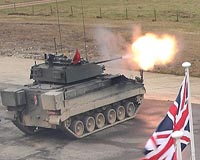| . |  |
. |
London, UK (SPX) Nov 24, 2009 From the dawn of the tank, armed soldiers bulked out in full kit have had to endure an up-close-and-personal relationship with their neighbours. In fairness, troops have rarely expected anything else. Throughout the past century, their metal battlefield workhorses have never been designed for comfort, with protection, mobility and overwhelming firepower the key concerns in battle. But fast-forward to campaigns in Iraq and Afghanistan and the squeeze has become tighter than ever. With a plethora of urgent operational requirements and upgraded armour to counter new threats, travelling around the 21st century theatre in heat of 50 degrees Celsius can become uncomfortable to the point of unbearable. Fortunately, experts are working to alleviate the strains on infantrymen and crews. With means of transport becoming more sophisticated, the MOD's Force Protection Working Group has been collaborating with industry to cut the need for a vehicle's underpinnings to be changed each time it is upgraded with a new system. The Generic Vehicle Architecture (GVA) project aims to create a single, standard electronic platform in new vehicles that will enable them to be easily adapted when the need arises, cutting the requirement for bulky, bolt-on extras. "Interoperability is key at the moment," said Mark Stusnick, a combat systems and electronic warfare platform manager with Force Protection Inc - the company behind the Cougar chassis used for the Mastiff and Ridgback vehicles. "It is one of our main priorities and is at the forefront of what we are doing. "These days you definitely need a modular approach to projects and to be able to introduce different sensors and weapons to your vehicle. When you are involved in a mission such as Afghanistan, you need to be able to plug in and play." The Cougar 4x4 was chosen as the vehicle of choice for American defence contractor General Dynamics to showcase its GVA prototype. Called the Core Infrastructure Distribution System, technicians have plumbed in a digital network that brings a new dimension to armoured warfare. Armed with a full suite of discrete cameras mated to compact screens, crews and dismounted soldiers have full sight of what is going on in the outside world around them. Weapons can be fired remotely with the hatch down, and data from vehicle systems can be instantly accessed to diagnose any problems: "We have essentially looked at an end-to-end solution, even down to where the equipment is mounted," said Karl Pfister, an engineer with General Dynamics. "We have also made it easy to plumb new systems into the vehicle. "The crew station has a virtual dashboard and the driver can see all around the platform via the cameras. The commander also has access to these different views and video from the weapon station, and can see the overall health of the vehicle." As well as being able to plug into electronic systems, crews can use network-enabled capability to access other assets, including unmanned air and ground vehicles, and this is a key feature of the generic architecture concept provided by Thales. The mock-up of the company's Bushmaster vehicle has a raft of linked-up kit, including a package called Imagery-on-Demand. Essentially a digital image compression and dissemination product, the feature allows operators in the vehicle to access high-quality video from sensors all over the battlefield, whether they are mounted on aircraft or units on the ground. Also linked in to the Bushmaster mock-up is the Thales Protector remote station, which can be fitted with a variety of weapons. And, once again, the common architecture makes for a much cleaner and more organised workspace for the crew: "Soldiers now are certainly more switched on when it comes to technology," said Thales spokesman Paul Mottershead. "They are used to playing on their PlayStation 3s and mobile phones, so they are already familiar with network capabilities. Imagery-on-Demand is very clever stuff and fits naturally with them. "The Protector weapons station features thermal imaging, has a laser range-finder and a colour day-camera. It is an extremely good system to engage targets with and you can fit a 7.62-calibre weapon, grenade machine gun or missiles." Overwhelming firepower is certainly a key asset against the Taliban in Afghanistan. But so too is the need to deliver it precisely, and creating a standard vehicle platform that supports a wide variety of applications is a huge advantage. To this end, the GVA initiative will be vital in future operations. With the benefit of battle-winning data, and the ability to plug into information sources from across theatre, soldiers will be able to find, fix and engage the enemy more effectively than ever before. And they'll even be more comfortable doing it. Share This Article With Planet Earth
Related Links UK MoD The latest in Military Technology for the 21st century at SpaceWar.com
 UK MoD Upgrade Bid Promises More Punch For Army Warriors
UK MoD Upgrade Bid Promises More Punch For Army WarriorsLeicester UK (SPX) Nov 24, 2009 British Army Warrior infantry fighting vehicles are set for a major boost in combat effectiveness by 2013 if a BAE Systems bid to upgrade the fleet is successful. The bid, submitted a day before the 18 Nov deadline, is for the GBP1bn Warrior Capability Sustainment Programme (WCSP), which will provide the mainstay of the Infantry's frontline fleet in Afghanistan and future conflicts. ... read more |
|
| The content herein, unless otherwise known to be public domain, are Copyright 1995-2009 - SpaceDaily. AFP and UPI Wire Stories are copyright Agence France-Presse and United Press International. ESA Portal Reports are copyright European Space Agency. All NASA sourced material is public domain. Additional copyrights may apply in whole or part to other bona fide parties. Advertising does not imply endorsement,agreement or approval of any opinions, statements or information provided by SpaceDaily on any Web page published or hosted by SpaceDaily. Privacy Statement |